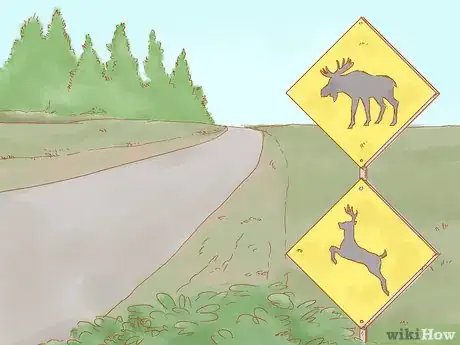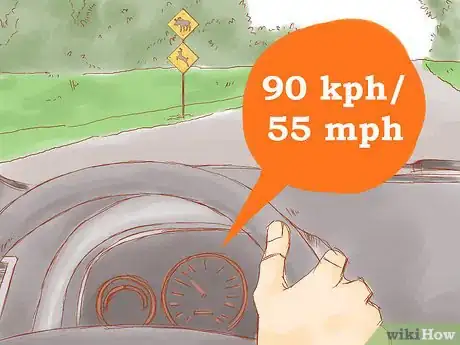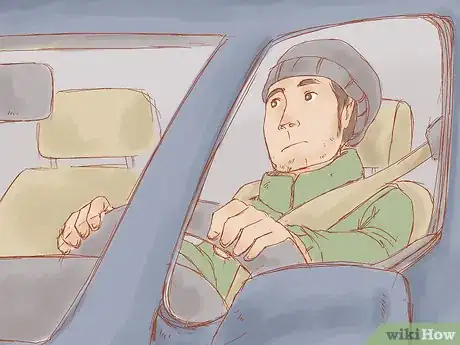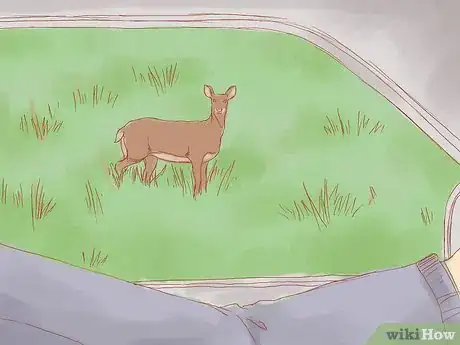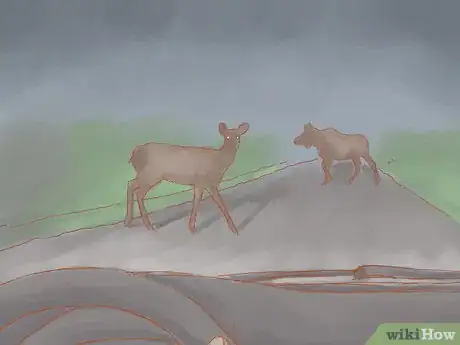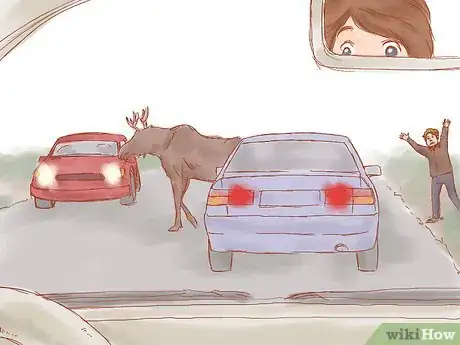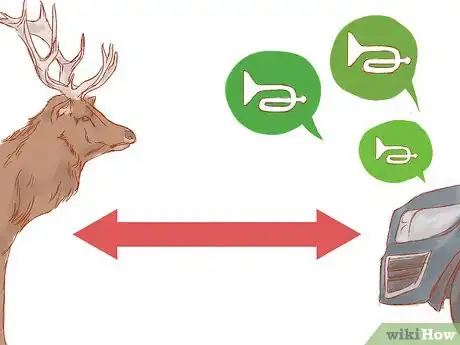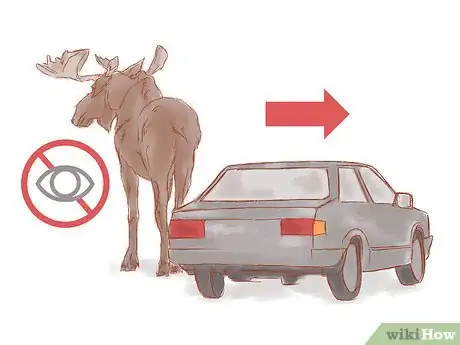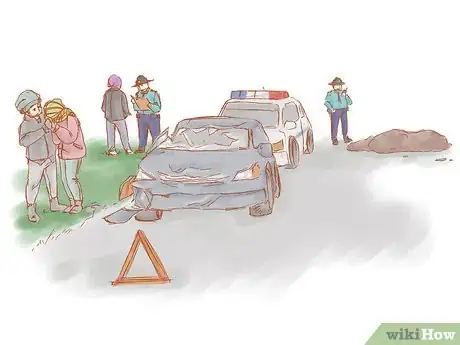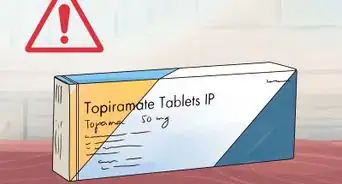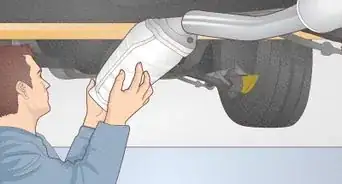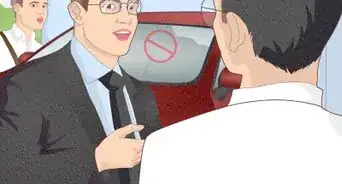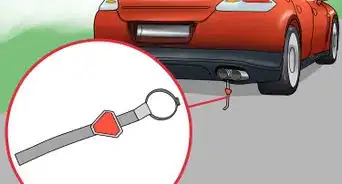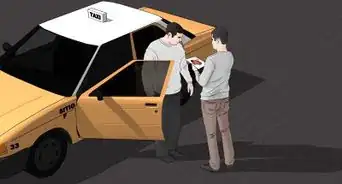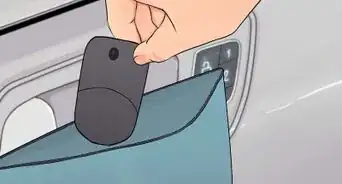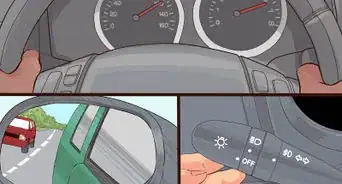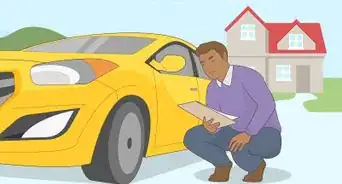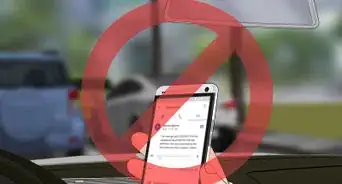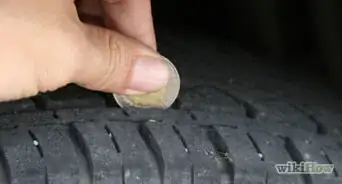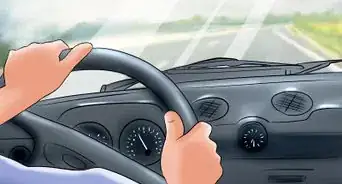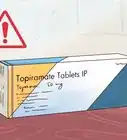This article was co-authored by Jacqueline Regev. Jacqueline Regev is a Driving Instructor and the Founder & CEO of Bubble of Safety Driving School. With over 20 years of education experience, she specializes in encouraging people to develop their skills to become safe and courteous drivers. Jacqueline earned a Bachelor's Degree from UCLA and an MA from Chapman University. She is also pursuing a PhD from UC Santa Barbara.
wikiHow marks an article as reader-approved once it receives enough positive feedback. In this case, 100% of readers who voted found the article helpful, earning it our reader-approved status.
This article has been viewed 304,639 times.
Every year, moose and deer collisions are the cause of hundreds of thousands of car accidents along North American and Northern European roads. Colliding with these animals, particularly moose, is potentially fatal for passengers and is likely to cause significant damage to your car -- and to the animals. If you want to avoid a moose or deer collision, you have to be alert and know what to do if you come head-to-head with one. Here's how to do it.[1]
Steps
Avoiding a Collision
-
1Heed the warning signs. Collisions occur most often in prime moose or deer habitats such as forested areas and waterways. If you see a deer or moose crossing sign, be extra alert and slow down. Moose and deer cross roads for a wide variety of reasons and at different times of the year. Often they want to get to another part of their habitat. Rutting season and hunting season also cause them to move. Stay alert.[2]
-
2Drive at a safe speed. Do not speed when you are driving through moose or deer country. You'll still arrive if you go more slowly and you'll have more time to avoid an animal if you spot it. Wildlife experts have recommended 90 kph/55 mph as a suitable speed for wildlife zones in good weather conditions, as it provides you with some reaction time to stop. Here are the things that suffer when you travel at too great a speed:
- You can't stop quickly enough to avoid a collision.
- The impact of a car/truck is far greater the faster you travel.
- Your ability to take evasive action is massively reduced and you're more likely to resort to swerving instead of braking and gently responding.
Advertisement -
3Drive defensively. Be prepared to take evasive action, which includes being able to quickly slow down, brake suddenly or turn down blinding headlights. Drive so that you are able to stop within the space of your headlights; practice this in a safe area if you don't know how fast this is for your vehicle. Make sure your seat belt is on and check that all passengers are wearing theirs as well. A sudden lurch could have people catapulting from the car.[3]
-
4Observe your surroundings. Actively scan the sides of the roads as you drive for any signs of wildlife. If you have passengers, get them involved but ask them not to shout out as this is very startling and can cause the driver to react incorrectly. Ask them to calmly tell you that they see moose or deer lurking about. Look on the road sides, the shoulders, down into ditches (they love the grass there), median strips, intersecting roads, on the road itself and try to spot any signs of movement, flashes of eyes or body shapes.
- Watch both sides of the road; there is some evidence that drivers tend to watch the side of the road next to the passenger seat more than their own side, making a false assumption that only one side is a problem. Scan both sides!
- Drivers are responsible for scanning the area ahead of them as if they are a catcher on a baseball field scanning the left and right field.
- When driving at night, it is necessary to look for things that could dart into the road, such as animals, children, or cars reversing from driveways.
- So scanning from the proximity of the left mirror across to the right mirror and back again is an important part of previewing the road and making sure that you are aware of obstacles that could jump out.
-
5Be especially wary at sunset and sunrise. Deer and moose seem to move most in the hours around sunset to midnight and again around dawn. These are also the hardest times for our eyes to adjust to the light because it's neither completely dark nor properly light, so we find it more difficult to see well. If you don't feel alert or can't see properly at these times, save your trip for another time.[4]
- Be on the lookout -- if you see one deer or moose, there are likely to be more deer or moose nearby, even if you don't see them. If you see one creature, it's more likely that you'll run into more.
-
6Drive carefully at night. Use your high beams where possible and when there are no oncoming cars that you can startle with them; they will illuminate more of the area that you are traveling through. Here are some other precautions to take when you're driving in the dark:
- Move into the centre lane if you are traveling in a 3 lane road, or centre the car as much as possible if it is a 2 lane road.
- Make sure your windshield is clear and is not reflecting grime, preventing you from seeing clearly.
- Drive below the speed limit, which has fuel economy benefits as well as safety benefits.
- Scan the sides of the road for animals' reflective eyes, often visible at a great distance at night. Sometimes this is the only visible part of the animal until it is directly in your path.
-
7Slow down when other cars are behaving differently. If you see flashing lights (hazard or headlights), hear tooting horns or see people waving madly about, slow down and be ready to stop! Of course, if a car stops suddenly ahead of you, you should also stop or at least slow right down. In these situations, the other cars may well have stopped because animals are already crossing the road ahead of you.
-
8Be alert -- even when you're approaching a town or a city. You've just driven into the outskirts of town, so everything is safe now, right? Wrong! Moose and deer wander into towns and city outskirts in search of food. They could be munching away on the median strip or bolting from someone's front garden. Still drive carefully. When you do come across a deer or a moose, don't expect them to react rationally.[5]
- Blasting horns, flashing lights, and a swerving metal machine are likely to terrify the animal witlessly and it will more than likely dart into your way rather than out of it. Bucks have been known to charge a stopped or moving cars of any size.[6]
-
9Know when not to swerve. If you suddenly have a deer before your car, brake firmly. Do not swerve and leave your lane; many accidents are not due to colliding with the deer but are the result of driving into another car or truck in the opposite lane while trying to avoid the animal. The best thing to do is drive defensively in the first place and go slowly enough that you won't collide with a moose and can brake in time.[7]
-
10Honk your horn at the deer or moose in short bursts. Only do this if the deer is far enough ahead and there are no cars around that can be disoriented by the honking. This may scare the deer away, but there's no guarantee that it will make the deer run off the road. If you're quite close to the deer, you may want to avoid honking at it, because the deer may get confused and come closer to you.
What to Do During a Collision
-
1Diminish the impact if it is inevitable. If an accident with a deer or moose is inevitable, here are some suggestions for lessening the impact:[8]
- Try to move to where the animal came from. This may take you away from it and the animal is more likely to keep moving forward rather than backtracking. This will only work if there is one animal. This will not work for deer.
- Shift your line of eyesight to that spot as well - don't look at the animal or you'll steer that way.
- Try to skim rather than fully impact the animal. Brake firmly, angle the car/truck and take your foot off the brake as you impact. The release of the brake will cause a slight lift of the vehicle and this may be enough to stop the animal from rising into your windshield if your vehicle is tall enough.
- If you're heading into a collision with a moose, lean toward the door pillar. In the Mythbusters where they tested this, the center of the car was completely crushed in every impact but the triangle by the door pillar was intact in each accident. No guarantees are offered; you are far better off avoiding the collision.
-
2Take care after a collision with a deer or moose. There are some important steps to take after assessing if everyone is relatively unharmed:[9]
- Pull over if possible. Put your hazard lights on and if you can, put the headlights onto the animal or as close as possible.
- Check passengers for injuries and treat accordingly. Even if there are no injuries, shock will probably occur fairly quickly. Try to reassure one another and if it is cold, put on warmer clothing immediately as shock or fear increases the inability to ward off cold. If it is winter, stay in the car for warmth.
- Avoid going near the animal; it may kick or gore you from fear and pain. If it blocks the road, use your hazard lights and headlights and keep your car stationary. Only attempt to move the animal if you are 100% certain that it is dead.
- Use road flares or triangles if you have them.
- Call the police immediately or flag down help. Remember that most insurance companies won't pay for the damages you suffer from hitting a deer or a moose if you don't file a police report.
Community Q&A
-
QuestionDoes the animal usually die?
 Community AnswerNot immediately, but local authorities will often come out and put the animal down if it doesn't die. Usually the animal will be severely injured and in pain, so putting it down is the more humane option.
Community AnswerNot immediately, but local authorities will often come out and put the animal down if it doesn't die. Usually the animal will be severely injured and in pain, so putting it down is the more humane option. -
QuestionWhat should I do if I'm driving at night and I go around a curve and there is a deer in the road?
 Community AnswerHit the brakes as hard as you can (if you drive a manual, hit the clutch too). Don't try to evade the deer, because this will most likely make your car spin. Try to keep the steering wheel straight. If you hit the deer, pull over and put your hazards on. If you have something like a warning triangle, you should put it before the curve to warn other drivers. Call 911 (or whatever number your country uses for emergency services) so they can take care of the deer and tow your car if necessary.
Community AnswerHit the brakes as hard as you can (if you drive a manual, hit the clutch too). Don't try to evade the deer, because this will most likely make your car spin. Try to keep the steering wheel straight. If you hit the deer, pull over and put your hazards on. If you have something like a warning triangle, you should put it before the curve to warn other drivers. Call 911 (or whatever number your country uses for emergency services) so they can take care of the deer and tow your car if necessary. -
QuestionWhat do I do if I'm in a convertible and encounter a moose on the road?
 Community AnswerA frontal collision with a moose will likely destroy your car. Swerve immediately. If the animal is some distance away, brake. You may have to go off the road. If you are driving at night, alternating the lights between full, dim and flashing may scare away the moose.
Community AnswerA frontal collision with a moose will likely destroy your car. Swerve immediately. If the animal is some distance away, brake. You may have to go off the road. If you are driving at night, alternating the lights between full, dim and flashing may scare away the moose.
Warnings
- Fences along the roads are not an assurance of safety. Deer or moose can walk around them, through them or over them. Don't rely on them; for peace of mind, drive carefully instead.⧼thumbs_response⧽
- Don't switch on the vehicle's internal lights. This causes glare on the inside of the windshield which could reduce visibility and make the animals harder to see.⧼thumbs_response⧽
- Don't honk at a moose if there is one on the side of the road as you do with deer. The moose is an aggressive animal and might try to charge your car, which will harm you and the car but not the moose if it was charging with antlers forward. Instead, drive along without changing speed past the moose.⧼thumbs_response⧽
- Deer whistles are somewhat of a gimmick; do not expect them to work.⧼thumbs_response⧽
- Also, moose are dark coloured, increasing the difficulty of seeing them at night. Always drive with caution if you believe there are any moose nearby.⧼thumbs_response⧽
- The eyes of a moose do reflect light like those of a deer. The problem is that since moose are so tall, their eyes are often above the beams of most passenger vehicles, making it less likely that they will reflect head lights, which can make them especially hard to see at night.⧼thumbs_response⧽
- Do not drive if you are sleepy or you have had alcohol. Being sober is not only a prerequisite for driving safely, it is also essential for avoiding collisions with animals.⧼thumbs_response⧽
- If you swerve away from a deer or moose in the road and hit something else, like a safety rail or tree, your automobile insurance may charge you for an at-fault accident and make you pay your collision deductible. If you hit the animal you will pay your comprehensive deductible, which is often lower than your collision deductible.⧼thumbs_response⧽
- A moose has been known to kill even a wild bear to protect her young. Deer have wounded or even killed a person to protect her calves. Even if you mean no harm to the calves the moose or deer will not perceive it that way.⧼thumbs_response⧽
- These tips will NOT work on other hoofed quadrupeds such as horses or reindeer and can only be used safely on deer or moose.⧼thumbs_response⧽
References
- ↑ https://www.dot.ny.gov/programs/deerandmoose
- ↑ https://www.maine.gov/mdot/safety/wildlife/
- ↑ https://www.cdc.gov/motorvehiclesafety/seatbeltbrief/index.html
- ↑ https://www.maine.gov/mdot/safety/wildlife/
- ↑ http://www.urbanhabitats.org/v07n01/moose_full.html
- ↑ http://www.theheartofnewengland.com/lifeinnewengland/Tips/moose-driving-tips.html
- ↑ https://www.dot.ny.gov/programs/deerandmoose
- ↑ https://www.maine.gov/mdot/safety/wildlife/
- ↑ https://www.statefarm.com/simple-insights/safety/6-immediate-steps-to-take-if-you-hit-a-deer-with-your-car
